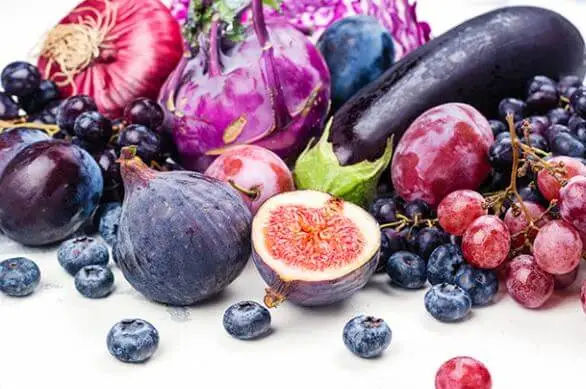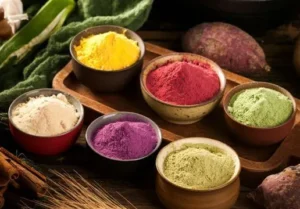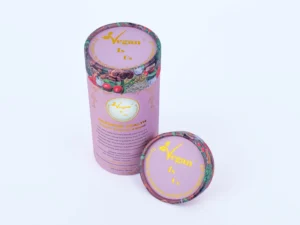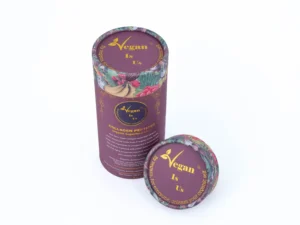One of the most effective ways to support overall health is to “eat the rainbow.” This means incorporating a variety of colourful plant-based foods into your diet to maximise nutrient intake. Among these, purple, red, and blue-hued fruits and vegetables contain a powerful plant compound called anthocyanin—an antioxidant-rich flavonoid with numerous health benefits. In this blog, we explore the health benefits of anthocyanins.
What Are Anthocyanins?
Anthocyanins (an-tho-SY-uh-nins) are natural pigments responsible for the deep red, purple, and blue hues in plants. They belong to the flavonoid family—bioactive plant compounds known for their antioxidant and anti-inflammatory properties. Found in fruits, vegetables, seeds, flowers, and leaves, anthocyanins help plants attract pollinators and protect against environmental stressors like UV radiation, drought, and cold. Research suggests that anthocyanins offer significant health benefits by combating oxidative stress and inflammation—two key contributors to chronic disease.
Top Food Sources of Anthocyanins
Foods rich in anthocyanins tend to have deep red, blue, purple, or black hues. Berries are the most concentrated sources, but many other plant-based foods contain these beneficial compounds:
Fruits:
- Black elderberries, aronia berries (chokeberries), blueberries, blackberries, raspberries, strawberries
- Black plums, blood oranges, cherries, black and red grapes, pomegranates
- Gooseberries
Vegetables:
- Red cabbage, red onions, red radishes
- Purple cauliflower, purple corn, purple aubergine (skin)
- Beetroot, kale
Legumes & Grains:
- Black beans, black rice, black soya beans
Beverages:
- Grape juice, red wine, hibiscus tea
Other Sources:
- Rosehip, sumac berry, goji berry, matcha
Fresh and frozen options retain the highest anthocyanin levels. You can also find anthocyanin-rich extracts and supplements, such as elderberry, aronia, tart cherry, and blueberry.
7 Health Benefits of Anthocyanins
1. Supports Heart Health & Lowers Blood Pressure
Anthocyanins may help lower blood pressure and support cardiovascular health. Clinical studies using anthocyanins have shown a significant decrease in inflammation markers and oxidative stress, a beneficial effect on vascular function. Anthocyanins also help prevent plaque buildup in arteries, reducing the risk of heart disease, stroke, and hypertension. The mechanism behind this benefit lies in the ability of anthocyanins to improve endothelial function, which is the health of the inner lining of blood vessels. By enhancing nitric oxide production, anthocyanins help blood vessels relax and improve blood flow, thereby reducing blood pressure. Additionally, their antioxidant properties help reduce oxidative stress, a key factor in the development of cardiovascular diseases.
2. Reduces Inflammation & Oxidative Stress
Inflammation and oxidative stress contribute to various chronic diseases, including diabetes, arthritis, and neurodegenerative disorders. As potent antioxidants, anthocyanins neutralise harmful free radicals and reduce inflammation, supporting long-term health and disease prevention. Oxidative stress occurs when there is an imbalance between free radicals and antioxidants in the body. Free radicals are unstable molecules that can damage cells, proteins, and DNA, leading to chronic inflammation and disease. Anthocyanins help restore this balance by scavenging free radicals and reducing oxidative damage. Their anti-inflammatory properties also help modulate the body’s immune response, reducing chronic inflammation that can lead to conditions like arthritis and inflammatory bowel disease.
3. Boosts Brain Function & Protects Against Cognitive Decline
Research shows anthocyanins enhance memory, cognitive function, and brain health by increasing blood flow to key brain areas. A study on older adults found that drinking cherry juice daily improved speech and memory. Other research suggests anthocyanins may help protect against Alzheimer’s disease and age-related cognitive decline. The neuroprotective effects of anthocyanins are attributed to their ability to cross the blood-brain barrier and exert antioxidant and anti-inflammatory effects directly in the brain. They help reduce the accumulation of amyloid-beta plaques, which are associated with Alzheimer’s disease. Additionally, anthocyanins promote the production of brain-derived neurotrophic factor (BDNF), a protein that supports the survival, growth, and differentiation of neurons, thereby enhancing cognitive function and memory.
4. May Reduce Cancer Risk & Slow Tumour Growth
Laboratory studies indicate that anthocyanins may prevent DNA mutations that lead to cancer, slow tumour growth, and enhance the effectiveness of chemotherapy. However, more human clinical trials are needed to confirm these findings. Anthocyanins exert their anti-cancer effects through multiple mechanisms. They inhibit the proliferation of cancer cells, induce apoptosis (programmed cell death), and prevent the formation of new blood vessels that supply tumours (angiogenesis). Additionally, anthocyanins help protect DNA from damage caused by free radicals and environmental toxins, reducing the risk of mutations that can lead to cancer. While these findings are promising, more research is needed to fully understand the role of anthocyanins in cancer prevention and treatment.
5. Supports Eye Health & Protects Vision
Anthocyanins may help protect against age-related vision problems, such as macular degeneration and cataracts. Their antioxidant properties support retinal health and improve blood circulation to the eyes, potentially enhancing night vision and reducing eye strain. The retina is particularly susceptible to oxidative damage due to its high metabolic activity and exposure to light. Anthocyanins help protect retinal cells from oxidative stress and inflammation, reducing the risk of age-related macular degeneration (AMD) and cataracts. They also improve blood flow to the eyes, enhancing the delivery of oxygen and nutrients to retinal tissues. Some studies suggest that anthocyanins may improve night vision by enhancing the regeneration of rhodopsin, a pigment in the retina that is essential for low-light vision.
6. Aids in Weight Management & Metabolism
Anthocyanin-rich foods, particularly berries, have been linked to improved metabolism, fat oxidation, and insulin sensitivity. Some studies suggest they may help with weight management by reducing inflammation and regulating blood sugar levels. Anthocyanins help regulate metabolism by influencing the expression of genes involved in fat metabolism and energy expenditure. They promote the breakdown of fats (lipolysis) and inhibit the formation of new fat cells (adipogenesis). Additionally, anthocyanins improve insulin sensitivity, helping to regulate blood sugar levels and reduce the risk of type 2 diabetes. By reducing inflammation and oxidative stress, anthocyanins also help prevent the metabolic dysfunction that can lead to obesity and related conditions.
7. Enhances Gut Health & Digestion
Anthocyanins promote a healthy gut microbiome by supporting beneficial gut bacteria and reducing harmful microbes. This can improve digestion, reduce bloating, and support overall gut health. The gut microbiome plays a crucial role in digestion, immune function, and overall health. Anthocyanins act as prebiotics, providing nourishment for beneficial gut bacteria such as Lactobacillus and Bifidobacterium. By promoting the growth of these beneficial bacteria, anthocyanins help maintain a healthy balance of gut microbiota, which is essential for proper digestion and nutrient absorption. Additionally, anthocyanins help reduce inflammation in the gut, which can alleviate symptoms of digestive disorders such as irritable bowel syndrome (IBS) and inflammatory bowel disease (IBD).
Frequently Asked Questions
How Much Anthocyanin Should You Consume Daily?
Unlike essential vitamins and minerals, there is no official daily recommended intake for anthocyanins. However, including a variety of anthocyanin-rich foods in your diet can provide powerful health benefits. Aim to consume at least one serving of anthocyanin-rich fruits or vegetables daily, such as a handful of berries, a serving of red cabbage, or a glass of pomegranate juice.
Should You Take Anthocyanin Supplements?
While anthocyanin supplements are widely available, whole foods remain the best source due to their synergy with other nutrients. Whole foods contain a complex matrix of vitamins, minerals, fibre, and other bioactive compounds that work together to enhance the health benefits of anthocyanins. If considering a supplement, consult your healthcare provider to ensure it does not interfere with any medications or health conditions.
Key Takeaways
Adding more anthocyanin-rich foods to your diet is an easy and natural way to boost overall health. Whether through berries, purple vegetables, or whole grains, these powerful plant compounds provide antioxidant, anti-inflammatory, and heart-protective benefits. For optimal health, aim to incorporate a diverse range of colourful plant-based foods daily. By doing so, you can harness the power of anthocyanins to support your heart, brain, eyes, gut, and overall well-being.







